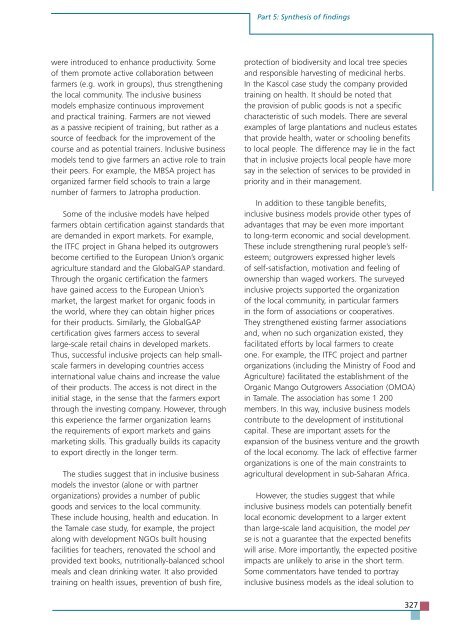TRENDS AND IMPACTS OF FOREIGN INVESTMENT IN DEVELOPING COUNTRY AGRICULTURE
TRENDS AND IMPACTS OF FOREIGN INVESTMENT IN DEVELOPING COUNTRY AGRICULTURE
TRENDS AND IMPACTS OF FOREIGN INVESTMENT IN DEVELOPING COUNTRY AGRICULTURE
Create successful ePaper yourself
Turn your PDF publications into a flip-book with our unique Google optimized e-Paper software.
were introduced to enhance productivity. Some<br />
of them promote active collaboration between<br />
farmers (e.g. work in groups), thus strengthening<br />
the local community. The inclusive business<br />
models emphasize continuous improvement<br />
and practical training. Farmers are not viewed<br />
as a passive recipient of training, but rather as a<br />
source of feedback for the improvement of the<br />
course and as potential trainers. Inclusive business<br />
models tend to give farmers an active role to train<br />
their peers. For example, the MBSA project has<br />
organized farmer field schools to train a large<br />
number of farmers to Jatropha production.<br />
Some of the inclusive models have helped<br />
farmers obtain certification against standards that<br />
are demanded in export markets. For example,<br />
the ITFC project in Ghana helped its outgrowers<br />
become certified to the European Union’s organic<br />
agriculture standard and the GlobalGAP standard.<br />
Through the organic certification the farmers<br />
have gained access to the European Union’s<br />
market, the largest market for organic foods in<br />
the world, where they can obtain higher prices<br />
for their products. Similarly, the GlobalGAP<br />
certification gives farmers access to several<br />
large-scale retail chains in developed markets.<br />
Thus, successful inclusive projects can help smallscale<br />
farmers in developing countries access<br />
international value chains and increase the value<br />
of their products. The access is not direct in the<br />
initial stage, in the sense that the farmers export<br />
through the investing company. However, through<br />
this experience the farmer organization learns<br />
the requirements of export markets and gains<br />
marketing skills. This gradually builds its capacity<br />
to export directly in the longer term.<br />
The studies suggest that in inclusive business<br />
models the investor (alone or with partner<br />
organizations) provides a number of public<br />
goods and services to the local community.<br />
These include housing, health and education. In<br />
the Tamale case study, for example, the project<br />
along with development NGOs built housing<br />
facilities for teachers, renovated the school and<br />
provided text books, nutritionally-balanced school<br />
meals and clean drinking water. It also provided<br />
training on health issues, prevention of bush fire,<br />
Part 5: Synthesis of findings<br />
protection of biodiversity and local tree species<br />
and responsible harvesting of medicinal herbs.<br />
In the Kascol case study the company provided<br />
training on health. It should be noted that<br />
the provision of public goods is not a specific<br />
characteristic of such models. There are several<br />
examples of large plantations and nucleus estates<br />
that provide health, water or schooling benefits<br />
to local people. The difference may lie in the fact<br />
that in inclusive projects local people have more<br />
say in the selection of services to be provided in<br />
priority and in their management.<br />
In addition to these tangible benefits,<br />
inclusive business models provide other types of<br />
advantages that may be even more important<br />
to long-term economic and social development.<br />
These include strengthening rural people’s selfesteem;<br />
outgrowers expressed higher levels<br />
of self-satisfaction, motivation and feeling of<br />
ownership than waged workers. The surveyed<br />
inclusive projects supported the organization<br />
of the local community, in particular farmers<br />
in the form of associations or cooperatives.<br />
They strengthened existing farmer associations<br />
and, when no such organization existed, they<br />
facilitated efforts by local farmers to create<br />
one. For example, the ITFC project and partner<br />
organizations (including the Ministry of Food and<br />
Agriculture) facilitated the establishment of the<br />
Organic Mango Outgrowers Association (OMOA)<br />
in Tamale. The association has some 1 200<br />
members. In this way, inclusive business models<br />
contribute to the development of institutional<br />
capital. These are important assets for the<br />
expansion of the business venture and the growth<br />
of the local economy. The lack of effective farmer<br />
organizations is one of the main constraints to<br />
agricultural development in sub-Saharan Africa.<br />
However, the studies suggest that while<br />
inclusive business models can potentially benefit<br />
local economic development to a larger extent<br />
than large-scale land acquisition, the model per<br />
se is not a guarantee that the expected benefits<br />
will arise. More importantly, the expected positive<br />
impacts are unlikely to arise in the short term.<br />
Some commentators have tended to portray<br />
inclusive business models as the ideal solution to<br />
327


